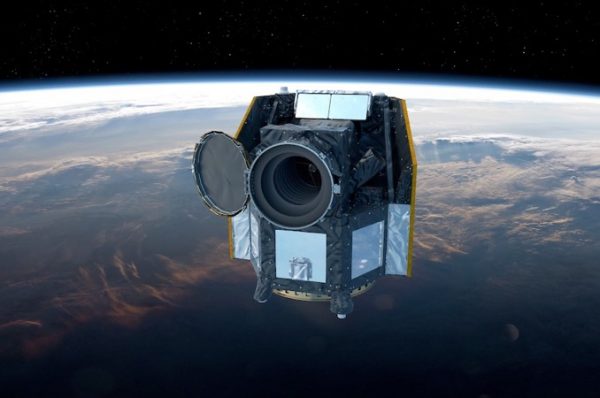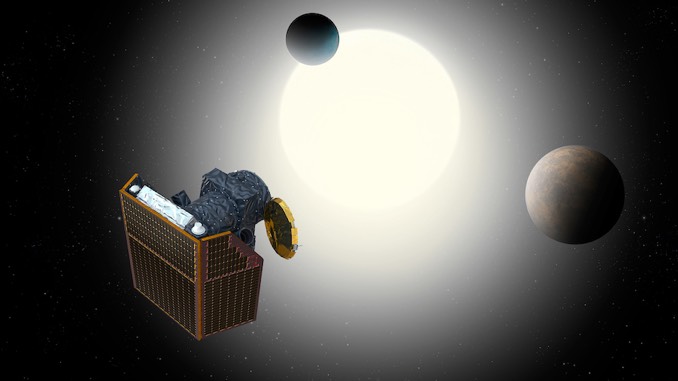CHEOPS launched on follow-up exoplanet research mission – Astronomy Now Online

A Russian-built Soyuz rocket boosted the European Space Agency’s CHEOPS spacecraft into space 18 December, kicking off an ambitious exoplanet research mission.
Designed to build upon discoveries made by previous pioneering exoplanet telescopes — like NASA’s Kepler mission — the ESA’s Characterising Exoplanet Satellite, or CHEOPS, mission was injected into orbit some 700 kilometres 435 miles) above Earth.
“We are extremely relieved,” said Günther Hasinger, ESA’s director of science. “CHEOPS is working. All systems are green. telemetry is stable, temperatures are fine, power voltages are fine, so everything is good to go.”
CHEOPS will be capable of registering tiny changes in the brightness of stars as planets block their light from reaching the telescope. This way of observing exoplanets is called the transit method, and it’s been used by Kepler, NASA’s TESS observatory and the French space agency’s CoRoT mission to discover planets around other stars.
Astronomers designed CHEOPS to follow up on discoveries made by other telescopes.
“What makes CHEOPS quite special to all the other transit missions so far is that CHEOPS is not really a discovery mission,” said Willy Benz, the mission’s principal investigator from the University of Bern in Switzerland. “It’s a follow-up. We will be looking at one system at a time, and not trying to discover thousands of others.”
“The idea is that we know now several thousands of these exoplanets,” Benz said. “We are more interested slowly toward characterising them with precision, knowing what they’re made of and their temperature, and so on and so forth.”
Astronomers can determine the mass of an exoplanet through a technique called the radial velocity method, in which telescopes can detect the wobble of a star caused by the pull of gravity from a smaller planetary companion. The amplitude of the wobble can tell scientists about the planet’s mass.
Combining the size information from CHEOPS with mass estimates obtained through other telescopes can yield significant insights into exoplanets, Benz said.
“By measuring the radius and by knowing the mass through radial velocity, we can place these different planets and try to figure out what they’re made of, whether they’re rocky planets, whether they’re a gas ball, an icy world, or the like,” he said. “You need to have pretty small error bars if you want to say anything meaningful about this, and this is why we need precision measurements.”

Didier Queloz, a Swiss astronomer at the University of Cambridge, won the 2019 Nobel Prize in Physics with Michel Mayor for their work in discovering the first exoplanet orbiting a sun-like star in 1995.
Queloz is chair of the CHEOPS science team. “We started this project more than 10 years ago, and now we’re in the sky,” he said.
“The field has just exploded,” he said after launch. “There are just thousands of exoplanets. There are a lot of planets known to be transiting, which means the planet goes right in front of the star, and that’s the technique that we’re using for the CHEOPS mission.
“We have so many planets, so different,” Queloz said. “We have these super-Earths, mini-Neptunes. We don’t really understand all these systems. So that’s the purpose of CHEOPS, providing new data, very precise data, to understand a bit better.”
CHEOPS can help identify prime targets for additional observations by future missions, such as the James Webb Space Telescope scheduled for launch in 2021.
“We want to look at atmospheres, following planets in their orbits around the star, we may want to see if a planet has moons, rings, and so on, and we want to provide the best targets for the very large facilities under construction or going into orbit like JWST,” Benz said.
David Ehrenreich, mission scientist for the CHEOPS consortium at the University of Geneva, said future large telescopes likes JWST and the Extremely Large Telescope in Chile will be under high demand.
“We think that in the coming years there will be far too many very interesting small planets to characterise with powerful facilities than observing time available on these over-booked facilities,” Ehrenreich said. “So it will become extremely important to down-select the golden target — the very best of these targets — so we could go and spend a lot of time with Hubble, with James Webb, and with the ELT on the ground.
“CHEOPS is going to be a key in this process by confirming and obtaining the first step characterisation of these many targets, and determining which one we should look for,” Ehrenreich said.






